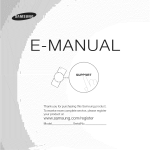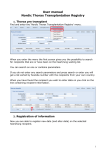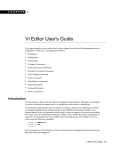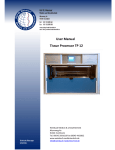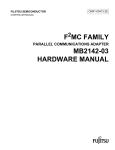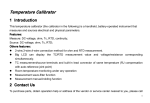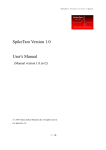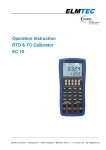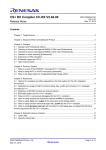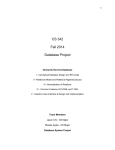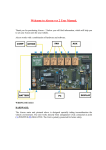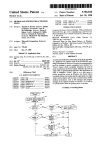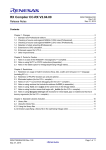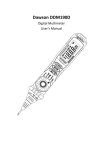Download M16C Edition - Renesas Electronics
Transcript
To our customers,
Old Company Name in Catalogs and Other Documents
On April 1st, 2010, NEC Electronics Corporation merged with Renesas Technology
Corporation, and Renesas Electronics Corporation took over all the business of both
companies. Therefore, although the old company name remains in this document, it is a valid
Renesas Electronics document. We appreciate your understanding.
Renesas Electronics website: http://www.renesas.com
April 1st, 2010
Renesas Electronics Corporation
Issued by: Renesas Electronics Corporation (http://www.renesas.com)
Send any inquiries to http://www.renesas.com/inquiry.
Notice
1.
2.
3.
4.
5.
6.
7.
All information included in this document is current as of the date this document is issued. Such information, however, is
subject to change without any prior notice. Before purchasing or using any Renesas Electronics products listed herein, please
confirm the latest product information with a Renesas Electronics sales office. Also, please pay regular and careful attention to
additional and different information to be disclosed by Renesas Electronics such as that disclosed through our website.
Renesas Electronics does not assume any liability for infringement of patents, copyrights, or other intellectual property rights
of third parties by or arising from the use of Renesas Electronics products or technical information described in this document.
No license, express, implied or otherwise, is granted hereby under any patents, copyrights or other intellectual property rights
of Renesas Electronics or others.
You should not alter, modify, copy, or otherwise misappropriate any Renesas Electronics product, whether in whole or in part.
Descriptions of circuits, software and other related information in this document are provided only to illustrate the operation of
semiconductor products and application examples. You are fully responsible for the incorporation of these circuits, software,
and information in the design of your equipment. Renesas Electronics assumes no responsibility for any losses incurred by
you or third parties arising from the use of these circuits, software, or information.
When exporting the products or technology described in this document, you should comply with the applicable export control
laws and regulations and follow the procedures required by such laws and regulations. You should not use Renesas
Electronics products or the technology described in this document for any purpose relating to military applications or use by
the military, including but not limited to the development of weapons of mass destruction. Renesas Electronics products and
technology may not be used for or incorporated into any products or systems whose manufacture, use, or sale is prohibited
under any applicable domestic or foreign laws or regulations.
Renesas Electronics has used reasonable care in preparing the information included in this document, but Renesas Electronics
does not warrant that such information is error free. Renesas Electronics assumes no liability whatsoever for any damages
incurred by you resulting from errors in or omissions from the information included herein.
Renesas Electronics products are classified according to the following three quality grades: “Standard”, “High Quality”, and
“Specific”. The recommended applications for each Renesas Electronics product depends on the product’s quality grade, as
indicated below. You must check the quality grade of each Renesas Electronics product before using it in a particular
application. You may not use any Renesas Electronics product for any application categorized as “Specific” without the prior
written consent of Renesas Electronics. Further, you may not use any Renesas Electronics product for any application for
which it is not intended without the prior written consent of Renesas Electronics. Renesas Electronics shall not be in any way
liable for any damages or losses incurred by you or third parties arising from the use of any Renesas Electronics product for an
application categorized as “Specific” or for which the product is not intended where you have failed to obtain the prior written
consent of Renesas Electronics. The quality grade of each Renesas Electronics product is “Standard” unless otherwise
expressly specified in a Renesas Electronics data sheets or data books, etc.
“Standard”:
8.
9.
10.
11.
12.
Computers; office equipment; communications equipment; test and measurement equipment; audio and visual
equipment; home electronic appliances; machine tools; personal electronic equipment; and industrial robots.
“High Quality”: Transportation equipment (automobiles, trains, ships, etc.); traffic control systems; anti-disaster systems; anticrime systems; safety equipment; and medical equipment not specifically designed for life support.
“Specific”:
Aircraft; aerospace equipment; submersible repeaters; nuclear reactor control systems; medical equipment or
systems for life support (e.g. artificial life support devices or systems), surgical implantations, or healthcare
intervention (e.g. excision, etc.), and any other applications or purposes that pose a direct threat to human life.
You should use the Renesas Electronics products described in this document within the range specified by Renesas Electronics,
especially with respect to the maximum rating, operating supply voltage range, movement power voltage range, heat radiation
characteristics, installation and other product characteristics. Renesas Electronics shall have no liability for malfunctions or
damages arising out of the use of Renesas Electronics products beyond such specified ranges.
Although Renesas Electronics endeavors to improve the quality and reliability of its products, semiconductor products have
specific characteristics such as the occurrence of failure at a certain rate and malfunctions under certain use conditions. Further,
Renesas Electronics products are not subject to radiation resistance design. Please be sure to implement safety measures to
guard them against the possibility of physical injury, and injury or damage caused by fire in the event of the failure of a
Renesas Electronics product, such as safety design for hardware and software including but not limited to redundancy, fire
control and malfunction prevention, appropriate treatment for aging degradation or any other appropriate measures. Because
the evaluation of microcomputer software alone is very difficult, please evaluate the safety of the final products or system
manufactured by you.
Please contact a Renesas Electronics sales office for details as to environmental matters such as the environmental
compatibility of each Renesas Electronics product. Please use Renesas Electronics products in compliance with all applicable
laws and regulations that regulate the inclusion or use of controlled substances, including without limitation, the EU RoHS
Directive. Renesas Electronics assumes no liability for damages or losses occurring as a result of your noncompliance with
applicable laws and regulations.
This document may not be reproduced or duplicated, in any form, in whole or in part, without prior written consent of Renesas
Electronics.
Please contact a Renesas Electronics sales office if you have any questions regarding the information contained in this
document or Renesas Electronics products, or if you have any other inquiries.
(Note 1) “Renesas Electronics” as used in this document means Renesas Electronics Corporation and also includes its majorityowned subsidiaries.
(Note 2) “Renesas Electronics product(s)” means any product developed or manufactured by or for Renesas Electronics.
Application Notes
RX Family C/C++ Compiler Package
Application Notes: RX Migration Guide, M16C Edition
This document explains the items that need to be checked for migration from M16C, for
C/C++ Compiler V1 for the RX family.
Table of Contents
Introduction................................................................................................................................................ 2
1.
1.1
1.2
1.3
Options .............................................................................................................................................. 3
Specifying changes to enumeration size .......................................................................................... 3
Specifying the size of double type variables ..................................................................................... 3
Specifying the size of int type variables ............................................................................................ 5
2.
2.1
2.2
2.3
2.4
2.5
2.6
2.7
2.8
2.9
2.10
Language specifications.................................................................................................................... 6
Size of int type variables ................................................................................................................... 6
Size of the double type...................................................................................................................... 7
Integer promotion for the char type ................................................................................................... 8
Placement of structure members ...................................................................................................... 9
Inline keywords................................................................................................................................ 10
#pragma STRUCT........................................................................................................................... 12
#pragma BITADDRESS .................................................................................................................. 14
#pragma ROM................................................................................................................................. 15
#pragma PARAMETER................................................................................................................... 16
asm.................................................................................................................................................. 17
3、Optimization option setting for migration from M16C-family.............................................................. 18
Exsample: Sample source....................................................................................................................... 19
Web site and support <website and support> ......................................................................................... 20
REJ06J0078-0100 /Rev.1.00
2009.10
Page 1 of 20
Application Notes
Introduction
In this application notes, it explains the software migration method when C program made by M16C-family compiler is
transplanted to RX-family compiler.
In Renesas RX-family compiler, the function to absorb the diference between the option and the language specification is supported
inconsideration of the migration from and M16C-family to RX-family. As a result, the application part of the embedded sofutware
can be smoothly transplanted.
In this application notes, it explains the use of the function that the difference between the option and the language specification of
the compiler for the M16C-family, and the RX-family and compilers for the RX-family support it.
Please use this application notes when you transplanted to RX-family from M16C-family.
REJ06J0078-0100 /Rev.1.00
2009.10
Page 2 of 20
Application Notes
1.
Options
Some specifications differ for the default options between M16C-family compilers and RX-family compilers. The following
explains options that will likely require handling during migration from M16C to RX.
Note that the expansion code in assembly code as used in this document can be obtained by specifying “output=src” and
“cpu=rx600”.
When the “cpu” option is different, the expansion code in assembly language may also differ. Also, the expansion code in
assembly language may change due to subsequent compiler improvements, so use this for reference.
Table 1-1 List of options
1.1
No
Functionality
RX option
Reference
1
Specifying changes to enumeration size
fchar_enumerator
M16C option
auto_enum
1.1
2
Specifying the size of double type variable
fdouble_32
dbl_size=4
1.2
3
Specifying the size of int type variables
--
int_to_short
1.3
Specifying changes to enumeration size
When the “fchar_enumerator” option is specified for M16C-family compilers, the enumerator type is treated as an unsigned char
type, not an int type.
To obtain the same results as those on RX-family compilers, specify the “auto_enum” option. Note that the unsigned char type is
only used for the enumerator type when the minimum enumerator value is 0, and the maximum value is 255. For all other cases,
another type is used.
For details about changing the enumeration type size, see 1.2.3 Enumeration type size in C/C++ Compiler Package for the RX
Family Application Notes: Compiler Usage Guide, Option Edition.
1.2
Specifying the size of double type variables
If the “fdouble_32” option is not specified for an M16C-family compiler, the size of the double type is treated as 8 bytes (double
precision).
For the same interpretation as RX-family compilers, specify the “dbl_size=8” option.
Format
dbl_size = {4|8}
REJ06J0078-0100 /Rev.1.00
: 4 by default
2009.10
Page 3 of 20
Application Notes
[How to specify this option in the Renesas IDE]
Choose Build and then RX Standard Toolchain, and perform the following settings in the displayed dialog box.
Figure 1-1
Figure 1-2
REJ06J0078-0100 /Rev.1.00
2009.10
Page 4 of 20
Application Notes
1.3
Specifying the size of int type variables
For M16C-family compilers, the size of the int type is treated as 2 bytes, whereas for RX-family compilers, the size of the int type
is treated as 4 bytes.
When migrating M16C programs created based on the requirement that the size of the int type is 2 bytes to RX, specify the
“int_to_short” option.
Format
int_to_short
[How to specify this option in the Renesas IDE]
In RX Standard Toolchain (Figure 1-1), choose Details, and perform the following settings in the displayed dialog box.
Figure 1-3
REJ06J0078-0100 /Rev.1.00
2009.10
Page 5 of 20
Application Notes
2.
Language specifications
This chapter explains the language specification most likely to require changes during RX migration.
Table 1-2 List of language specifications
No
2.1
Functionality
Reference
1
Size of int type
2.1
2
Size of the double type
2.2
3
Integer promotion for the char type
2.3
4
Placement of structure members
2.4
5
Inline keyword
2.5
6
#pragma STRUCT
2.6
7
#pragma BITADDRESS
2.7
8
#pragma ROM
2.8
10
#pragma PARAMETER
2.9
11
asm
2.10
Size of int type variables
On M16C-family compilers, the size of the int type is 2 bytes, whereas on RX-family compilers the size of the int type is 4 bytes
in default. When M16C programs created based on the requirement that the size of the int type is 2 bytes are migrated to RX, they
may not operate properly.
Example: Code for which operation is different due to variance in int type size
Source code
typedef union{
long data;
struct {
int dataH;
int dataL;
} s;
} UN;
void main(void)
{
UN u;
u.data = 0x7f6f5f4f;
if (u.s.dataH == 0x5f4f && u.s.dataL == 0x7f6f) {
// When the size of the int type is 2 bytes (M16C)
} else {
// When the size of the int type is 4 bytes (RX)
}
}
When migrating programs created based on the requirement that the size of the int type is 2 bytes to RX, specify the
“int_to_short” option. For details about specifying this option, see 1.3 Specifying the size of int type variables.
REJ06J0078-0100 /Rev.1.00
2009.10
Page 6 of 20
Application Notes
2.2
Size of the double type
With M16C-family compilers, the size of the double type is 8 bytes, whereas with RX-family compilers, the size of the double
type is 4 bytes in default。 When M16C programs created based on the requirement that the size of the double type is 8 bytes are
migrated to RX, they may not operate properly.
Example: Code for which operation is different due to variance in double type size
Source code
double d1 = 1E30;
double d2 = 1E20;
void main(void)
{
d1 = d1 * d1;
d2 = d2 * d2;
if (d1 > d2) {
// When the size of the double type is 8 bytes (M16C)
} else {
// When the size of the double type is 4 bytes (RX)
}
}
When migrating programs created based on the requirement that the size of the double type is 8 bytes to RX, specify the
“dbl_size=8” option. For details about specifying this option, see 1.2 Specifying the size of double type variable.
REJ06J0078-0100 /Rev.1.00
2009.10
Page 7 of 20
Application Notes
2.3
Integer promotion for the char type
With M16C-family compilers, when char type data (including unsigned char, signed char types) is evaluated, it is not promoted to
the int type, whereas with RX-family compilers, char type data is always promoted to the int type when evaluated. When migrating
to MX programs created based on this condition in M16C, operation may not be performed the same as M16C.
Example: Code for which operation is different due to variance in integer promotion specifications for char type
calculations
Source code
char c1;
char c2 = 200;
char c3 = 200;
void main(void)
{
c1 = (c2 + c3) / 2;
// Unexpected results occur on M16C, because the maximum
// value that can be expressed for the calculation of
// c2 + c3 causes an overflow
if (c1 == 200) {
// When the char type is promoted to the int type and evaluated (RX)
} else {
// When the char type is evaluated without being promoted to the int type (M16C)
}
}
Notes
Options exist for promotion to the int type when M16C-family compilers evaluate char type data (including unsigned char types
and signed char types). If one of the following options is specified, no problems will occur for the integer promotion specification
explained here.
• -fansi
• -fextend_to_int
REJ06J0078-0100 /Rev.1.00
2009.10
Page 8 of 20
Application Notes
2.4
Placement of structure members
M16C-family compilers place structure members in the order of appearance for member data with alignment count 1, whereas
RX-family compilers place structure members in the order of appearance for member data, according to the maximum alignment
count for members. When M16C programs created based on the requirement that M16C structure placement is used are migrated to
RX, they may not operate properly. In this case, the “pack” option can be specified to set the alignment count for structure members
to 1. Free space will no longer be able to be created for structures with alignment counts of 1.
Structure alignment counts can also be specified using #pragma pack. If both the option and #pragma are specified at the same
time, the #pragma specification takes precedence.
For details about this functionality, see 2.3 Specifying structure, shared structure, and class alignment count in C/C++ Compiler
Package for the RX Family Application Notes: Compiler Usage Guide, Extended Functionality Edition.
Format
pack
unpack
[How to specify this option in the Renesas IDE]
Choose the CPU tab, then choose Details (Figure 1-1), and then perform the following settings in the displayed dialog box.
Figure 1-4
REJ06J0078-0100 /Rev.1.00
2009.10
Page 9 of 20
Application Notes
2.5
Inline keywords
M16C-family compilers support inline keywords, whereas RX-family compilers do not support inline keywords for
ANSI-standard C89.
When a program using inline keywords for M16C is built on the RX ANSI-standard C89, inline keywords cause compilation
errors for non-standard builds. This can be resolved by either of the following:
• When performing builds using ANSI-standard C89, convert inline code to #pragma inline.
• Perform builds using ANSI-standard C99.
The following shows an example of converting inline keywords to #pragma inline.
Example:
Source code (using inline keywords)
Source code (using #pragma inline)
inline static int func(int a, int b)
{
return (a + b) / 2;
}
int x;
main()
{
x = func(10, 20);
}
#pragma inline(func)
static int func(int a, int b)
{
return (a + b) / 2;
}
int x;
main()
{
x = func(10, 20);
}
The option settings for builds on ANSI-standard c99 are as follows.
Format
lang={c|cpp|ecpp|c99}
[How to specify this option in the Renesas IDE]
From HEW, choose Build and then RX Standard Toolchain, and then perform the following settings in the displayed dialog box.
Figure 1-5
REJ06J0078-0100 /Rev.1.00
2009.10
Page 10 of 20
Application Notes
Precautions
1. The ANSI-standard C99, C++, and #pragma inline specifications differ as follows.
Table 1-3 Inline specifications
Default linkage
C99
Linkage when inline expansion
is not possible
Internal linkage
Internal linkage
When extern is specified:
Internal linkage
Internal linkage
When extern is specified:
External linkage
External linkage
When static is specified:
inline keyword
C++
External linkage
inline keyword
#pragma inline
Impact on declarative
linkage
Compilation error
Internal linkage
2, Progressing inline key word and #pragam inline is different. #pragma inline is compulsion development.
REJ06J0078-0100 /Rev.1.00
2009.10
Page 11 of 20
Application Notes
2.6
#pragma STRUCT
M16C-family compilers can prohibit structure packing using #pragma STRUCT, and perform sorting for structure members.
Since RX-family compilers lack the corresponding functionality, programs using #pragma STRUCT need special handling when
migrated to RX.
(1)
Prohibiting structure packing
By default, M16C-family compilers place structure members with alignment 1. This means that the structure size may be an odd
number of bytes. To make the structure size an even number of bytes, specify #pragma STRUCT unpack. If this specification causes
the structure size to be an odd number of bytes, 1 byte of padding is inserted to bring the structure size to an even number of bytes.
One of the following needs to be performed to achieve the same effect for RX-family compilers.
• Specify #pragma pack to set the structure alignment to 1.
• If setting the alignment to 1 causes the structure size to be an odd number of bytes, have users enter a 1-byte dummy member
for adjustment.
In addition to specifying #pragma pack, specifying the “pack” option is another way to set structure alignment to 1 on RX-family
compilers. For details about this functionality, see 2.4 Placement of structure members.
Example:
M16C program with #pragma STRUCT unpack and program migrated to RX
Source code with #pragma STRUCT unpack specified
RX source code
#pragma STRUCT s unpack
struct s {
short i;
char c;
short j;
} ss;
#pragma pack
struct s {
short i;
char c;
short j;
char dmy;
// To get a size with an even number
// of bytes a 1-byte dummy member
// is inserted
} ss;
i
c
j
#pragma STRUCT
adds 1 byte of
padding.
The structure
size is 6 bytes.
i
c
dmy
free
REJ06J0078-0100 /Rev.1.00
j
2009.10
Since the alignment
count is 1 due to
pack, there is no
free space. The
structure size is 6
bytes due to
explicitly
inserted members.
Page 12 of 20
Application Notes
(2)
Sorting structure members
RX-family compilers do not have any functionality to sort structure members. Programs need to be changed to perform member
sorting.
Example:
M16C program with #pragma STRUCT arrange and program migrated to RX
Source code with #pragma STRUCT arrange specified
RX source code
#pragma STRUCT s arrange
struct s {
short i;
char c;
short j;
} ss;
#pragma pack
struct s {
short i;
short j;
char c;
} ss;
i
j
c
#pragma STRUCT
places
even-byte
members before,
and odd-byte
members after.
// Placement of members ’j’ and ’c’
// is changed
i
j
c
Since the alignment
count is 1 due to
pack, there is no
free space. The
structure members
are placed in order
of appearance.
Notes
Keep in mind that the meanings of #pragma STRUCT unpack for M16C and #pragma unpack for RX are different.
• #pragma STRUCT unpack (M16C)
Adjusts the size of the specified structure to an even number of bytes.
• #pragma unpack (RX)
Makes the alignment of the specified structure the same as the maximum alignment count for members.
REJ06J0078-0100 /Rev.1.00
2009.10
Page 13 of 20
Application Notes
2.7
#pragma BITADDRESS
M16C-family compilers can allocate variables to a specified bit position for an absolute address specified by #pragma
BITADDRESS. Since RX-family compilers lack the corresponding functionality, programs using #pragma BITADDRESS need
special handling when migrated to RX.
The following gives an example where the absolute address bit position matches the structure bit field.
Example:
M16C program with 100th position bit number 1 for #pragma BITADDRESS set to 1 and program migrated to RX
Source code with #pragma BITADDRESS specified
RX source code
#pragma BITADDRESS
_Bool io;
struct bit_address {
unsigned char b0:1;
unsigned char b1:1;
unsigned char b2:1;
unsigned char b3:1;
unsigned char b4:1;
unsigned char b5:1;
unsigned char b6:1;
unsigned char b7:1;
};
io
1, 100H
void main(void)
{
io = 1;
}
#define io (((struct bit_address*)0x100)->b1)
void main(void)
{
io = 1;
}
Notes
When a program using the _Bool keyword on an M16C-family compiler is built on a RX-family compiler with ANSI-standard
C89, an error occurs because the _Bool keyword is non-standard. RX-family compilers support the _Bool keyword with
ANSI-standard C99.
REJ06J0078-0100 /Rev.1.00
2009.10
Page 14 of 20
Application Notes
2.8
#pragma ROM
M16C-family compilers place variables specified by #pragma ROM in the rom section. Since RX-family compilers lack the
corresponding functionality, when a program using #pragma ROM is migrated to RX, the const modifier needs to be used to place
variables in the rom section, as shown in the following example.
Example:
M16C program with variable ’i’ placed in the rom section using #pragma ROM, and program migrated to RX
Source code with #pragma ROM specified
RX source code
#pragma ROM i
unsigned short i;
const unsigned short
Assembler expansion code
Assembler expansion code
.SECTION rom_FE,ROMDATA,align
.glb
_i
_i:
.SECTION
.glb
_i:
.byte
.byte
00H
00H
REJ06J0078-0100 /Rev.1.00
.byte
.byte
2009.10
i;
// const keyword added
C_2,ROMDATA,ALIGN=2
_i
; static: i
00H
00H
Page 15 of 20
Application Notes
2.9
#pragma PARAMETER
M16C-family compilers can use #pragma PARAMETER to store arguments in a register and declare passed assembler functions.
Since RX-family compilers lack the corresponding functionality, programs using #pragma PARAMETER need special handling
when migrated to RX.
RX-family compilers have no way to specify that arguments be stored in arbitrary registers. The argument interface for function
calls needs to follow C/C++ generation rules. Change the argument interface for assembler functions specified by #pragma
PARAMETER during RX migration to adhere to C/C++ generation rules.
For details about argument interfaces, see 1.2 Performing inline expansion in assembly code functions in C/C++ Compiler
Package for the RX Family Application Notes: Compiler Usage Guide, Extended Functionality Edition.
Example:
M16C program using #pragma PARAMETER, and program combining the assembler function and argument interface in RX
Source code with #pragma PARAMETER specified
Source code using RX assembly code functions
C source code
C source code
int asm_func(unsigned int, unsigned int);
#pragma PARAMETER asm_func(R0, R1)
int asm_func(unsigned int, unsigned int);
void main(void)
{
int i, j;
void main(void)
{
int i, j;
i = 0x7FFD;
j = 0x007F;
i = 0x7FFD;
j = 0x007F;
asm_func( i, j );
asm_func( i, j ); // Assembler function call
// ’i’ is stored in R1, ’j’
// is stored in R0
}
// Assembler function call
// As per the C/C++ argument
// interface,
// ‘i’ is stored in R1, ’j’ is
// stored in R2
}
Assembler source code
Assembler source code
_asm_func:
Code requiring ‘i’ to be in R1, ’j’ to be in
R0 for passage
…
RTS
REJ06J0078-0100 /Rev.1.00
_asm_func:
Changing code requiring ‘i’ to be in R1, ’j’ to
be in R2 for passage
…
RTS
2009.10
Page 16 of 20
Application Notes
2.10
asm
M16C-family compilers can use the asm function to code assembly language routines (asm functions) within C source programs.
Since RX-family compilers lack the corresponding functionality, programs using asm functions need special handling when migrated
to RX.
Assembly code functions exist to code assembly language in a C source program in RX. The contents coded in the asm function
can sometimes be handled by being coded in the assembly code function.
For details about assembly code functions, see 1.2 Performing inline expansion in assembly code functions in C/C++ Compiler
Package for the RX Family Application Notes: Compiler Usage Guide, Extended Functionality Edition.
Example:
M16C program using the asm function, and program using the assembly code function in RX
(The code contents are not equivalent, but this can be used as an example of migration.)
Source code with the M16C asm function specified
Source code using the RX assembly code function
C source code
C source code
void func(void)
{
asm("FSET I");
}
#pragma inline_asm interrupt_flag
static void interrupt_flag(void)
{
MOV.L
#00010000H,R5
MVTC
R5,PSW
}
Assembler source expansion code
_func:
FSET I
rts
void func(void)
{
interrupt_flag();
}
Assembler source expansion code
_func:
MOV.L
MVTC
RTS
#00010000H,R5
R5,PSW
Precautions
•
•
M16C can code variables in the asm function, but RX cannot.
M16C can use a dummy asm function as a step to partially suppress optimization, but RX cannot.
REJ06J0078-0100 /Rev.1.00
2009.10
Page 17 of 20
Application Notes
3、Optimization option setting for migration from M16C-family
There is a difference in an optional setting method for optimization in the compiler of M16C-family and RX-family.
Please refer to the following optimization option setting when embedded software transplant from M16C-famiy to RX-family and
the performance is evaluated.
Optimization option setting of each compiler and comparison of ROM size
(The sample program for the measurement is described to the next page.)
M16C
Optimize OFF
Optimize Size
Optimize Speed
opt=0
opt=O3 OR
-
opt=OR_max
opt=O3 OS
-
opt=OS_max
main()
0xA2
0x80
-
0xA0
0xA1
-
0x27A
sort()
0xB3
0x79
-
0x79
0x7C
-
0x7B
RX
Optimize OFF
Optimize Size
Optimize Speed
opt=0
opt=1
opt=2
opt=max
opt=1 speed
opt=2 speed
opt=max
speed
main()
0xD1
0x95
0x6A
0x6A
0x95
0xEB
0x11A
sort()
0xFD
0x69
0x65
0x65
0x6A
0x5F
0x5F
Optimization option setting for migration from M16C-family
(1) Please specify it for RX-family above opt=1 or opt=1 speed when you specify opt=0 for M16C-family.
In opt=0 for RX-family, the meaning is different from opt=0 for M16C-family. Optimization is not executed at all.
Therefore, the performance of RX-family looks bad.
Exsample:
・If O0 for M16C is used, rom size is 0xA2 (main()) -> If optimize=0 for RX is used, rom size is 0xD1 (main()) …NG
・If O0 for M16C is used, rom size is 0xA2 (main()) -> If optimize=1 for RX is used, rom size is 0x95 (main()) …OK
Please refer to the compiler user's manual for details of the optimization level of the RX compiler.
REJ06J0078-0100 /Rev.1.00
2009.10
Page 18 of 20
Application Notes
Exsample: Sample source
#include <stdio.h>
#include <math.h>
#include <stdlib.h>
void main(void);
void sort(long *a);
void change(long *a);
void main(void)
{
long a[10];
long j;
int i;
printf("### Data Input ###¥n");
for( i=0; i<10; i++ ){
j = rand();
if(j < 0){
j = -j;
}
a[i] = j;
printf("a[%d]=%ld¥n",i,a[i]);
}
sort(a);
printf("*** Sorting results ***¥n");
for( i=0; i<10; i++ ){
printf("a[%d]=%ld¥n",i,a[i]);
}
change(a);
}
void sort(long *a)
void change(long *a)
{
{
long t;
long tmp[10];
int i, j, k, gap;
int i;
for(i=0; i<10; i++){
gap = 5;
tmp[i] = a[i];
while( gap > 0 ){
}
for( k=0; k<gap; k++){
for(i=0; i<10; i++){
for( i=k+gap; i<10; i=i+gap ){
a[i] = tmp[9 - i];
for(j=i-gap; j>=k; j=j-gap){
}
}
if(a[j]>a[j+gap]){
t = a[j];
a[j] = a[j+gap];
a[j+gap] = t;
}else{
break;
}
}
}
}
gap = gap/2;
}
}
REJ06J0078-0100 /Rev.1.00
2009.10
Page 19 of 20
Application Notes
Web site and support <website and support>
Web site for Renesas Technology
http://japan.renesas.com/
Contact information
http://japan.renesas.com/inquiry
[email protected]
Revision history<revision history,rh>
Rev.
1.00
Date issued
2009.10.1
REJ06J0078-0100 /Rev.1.00
Page
--
Contents changed
Details
Initial edition
2009.10
Page 20 of 20























